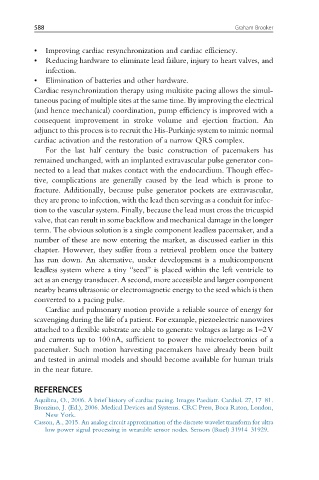Page 597 - Handbook of Biomechatronics
P. 597
588 Graham Brooker
• Improving cardiac resynchronization and cardiac efficiency.
• Reducing hardware to eliminate lead failure, injury to heart valves, and
infection.
• Elimination of batteries and other hardware.
Cardiac resynchronization therapy using multisite pacing allows the simul-
taneous pacing of multiple sites at the same time. By improving the electrical
(and hence mechanical) coordination, pump efficiency is improved with a
consequent improvement in stroke volume and ejection fraction. An
adjunct to this process is to recruit the His-Purkinje system to mimic normal
cardiac activation and the restoration of a narrow QRS complex.
For the last half century the basic construction of pacemakers has
remained unchanged, with an implanted extravascular pulse generator con-
nected to a lead that makes contact with the endocardium. Though effec-
tive, complications are generally caused by the lead which is prone to
fracture. Additionally, because pulse generator pockets are extravascular,
they are prone to infection, with the lead then serving as a conduit for infec-
tion to the vascular system. Finally, because the lead must cross the tricuspid
valve, that can result in some backflow and mechanical damage in the longer
term. The obvious solution is a single component leadless pacemaker, and a
number of these are now entering the market, as discussed earlier in this
chapter. However, they suffer from a retrieval problem once the battery
has run down. An alternative, under development is a multicomponent
leadless system where a tiny “seed” is placed within the left ventricle to
act as an energy transducer. A second, more accessible and larger component
nearby beams ultrasonic or electromagnetic energy to the seed which is then
converted to a pacing pulse.
Cardiac and pulmonary motion provide a reliable source of energy for
scavenging during the life of a patient. For example, piezoelectric nanowires
attached to a flexible substrate are able to generate voltages as large as 1–2V
and currents up to 100nA, sufficient to power the microelectronics of a
pacemaker. Such motion harvesting pacemakers have already been built
and tested in animal models and should become available for human trials
in the near future.
REFERENCES
Aquilina, O., 2006. A brief history of cardiac pacing. Images Paediatr. Cardiol. 27, 17–81.
Bronzino, J. (Ed.), 2006. Medical Devices and Systems. CRC Press, Boca Raton, London,
New York.
Casson, A., 2015. An analog circuit approximation of the discrete wavelet transform for ultra
low power signal processing in wearable sensor nodes. Sensors (Basel) 31914–31929.

